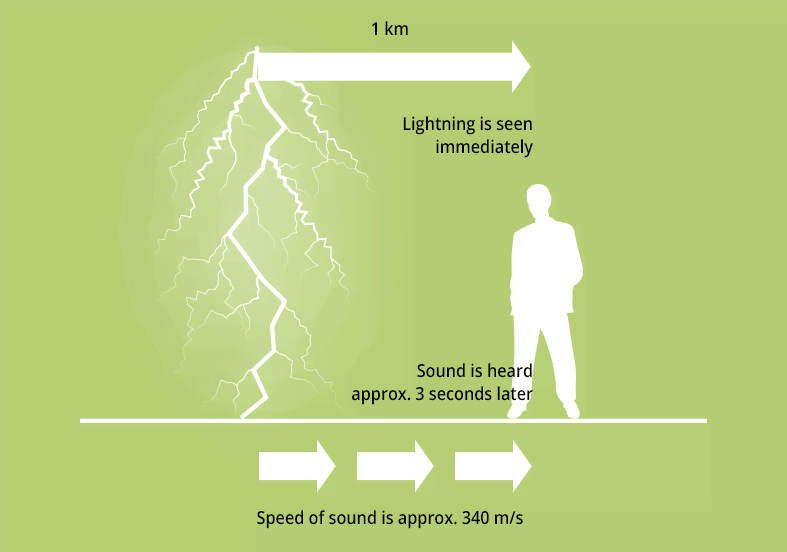Both compression and rarefaction are a local disturbance, and the air will try to find equilibrium. When the movement of the membrane increases the local pressure, air molecules right in front of the membrane will push against the molecules that are a little further away. Those molecules will in turn push against the molecules even further away and so on.
Similarly, when the membrane moves back into the box it reduces local pressure and air molecules follow to fill the space. Consequently, the molecules further away must follow as well. The molecules themselves only move back and forth a bit. What is transmitted from one molecule to the next is the energy of the movement.
The Speed of Sound
The speed at which this energy propagates away from the source is the speed of sound.
As a rule of thumb, the speed of sound in air is 340 m/s, but it increases and decreases with the air’s temperature:
Cair = (331 + 0.6 * T) m/s where T is the air’s temperature in °C.
This means one second after the loudspeaker membrane began to move, a listener 340 meters away from it will start to hear something. If during this second, the speaker’s membrane only does a single cycle of moving out, in, and back again, we say that it oscillates at a frequency of 1 Hz, which equals one cycle per second. Within that cycle, air pressure in front of the loudspeaker will have increased to a maximum before the membrane started to move back into the box, causing the pressure to decrease until it reaches a minimum, to then return to neutral.
If we could stop time after one second and walk 340 meters away from the loudspeaker, we would observe the pressure distribution in front of the loudspeaker reflecting the pressure variation, thus forming one complete wavelength.
Most humans first start to hear sound at 20 Hz, that is when the speaker performs 20 cycles per second. Sound still travels at the same speed away from the source, and it still takes one second before a listener at a 340-metre distance starts to hear something. However, in that time, the speaker will already have performed 20 cycles and if we again stop time, we will have a pattern in the air where the pressure varies 20 times between maximum and minimum.
The wavelength is defined as the length of this pattern for one cycle, and because we can fit 20 cycles into the distance of 340 meters, the wavelength for 20 Hz is 340 meters divided by 20, which is 17 meters. Equivalently, for 20 kHz, which is the highest frequency most humans can hear, the wavelength would be 340 meters divided by 20,000, and that is 1.7 cm.
Why Is Wavelength Important?
The importance of the wavelength is that it helps us to relate the dimensions of objects to the frequencies in the sound. This is relevant for almost all disciplines in acoustics.
Let’s take an example...
Standing Wave Patterns
Once a sound reaches a wall, ceiling, or floor, it will be reflected and interfere with other sound waves from the same or other sources. If the wavelength matches one or several dimensions of the room, these waves will create so-called 'standing wave patterns', by adding up in some areas (giving a booming impression) and cancel each other out in others (sound becomes weak).
Left: Match for the lowest frequency, that is, longest wavelength: Very strong sound at the walls. Weak or no sound in the middle of the room
Right: Match for the next higher frequency, where two wavelengths fit into the room: Strong sound at the walls and again in the middle of the room, alternating with areas of weak sound
Therefore, knowledge of the wavelengths for relevant frequencies can be used advantageously to accentuate certain frequencies (for example, the placement of subwoofers at walls or even in corners) or to avoid the effect, if so desired, by altering the shape and dimensions of the room.
Just as important as the size of the room, is the size of objects in it. Objects significantly smaller than the wavelength will not reflect sound because if the wavelength is large, there will be practically no pressure difference across the object, i.e. the presence of the object won’t matter. In contrast, if the wavelength of sound is comparably small, the object will act as a shield and reflector.
This is why moving behind a column will strongly reduce high frequencies (short wavelengths) but leave low-frequency sound almost un-changed (long wavelengths), making sound appear dull.
Wavelength of Sound In Air
Wavelength of a sound in air at 1 Hz: 340 m
A: These molecules already react to the inward motion of the loudspeaker membrane, moving towards the source.
B: 170 m = half the wavelength away from the membrane: Air molecules are in a neutral position and start to move towards the membrane
C: The wavefront has reached these molecules moving them in a direction away from the source
Wavelength of a sound in air at 20 Hz: 340 m / 20 = 17 m
Membrane motion
A: Membrane and air in the neutral position
B: Membrane out and air compressed
C: Membrane in and air rarefied
The Speed of Sound in Air
Have you ever counted the number of seconds that passed from the moment you saw a lightning strike until you heard the thunder?
Many will know the rule of thumb that counting to three means that the lightning struck about 1 km away. With this in mind, you can roughly calculate the speed of sound: 1 km / 3 seconds ≈ 340 m/s.
This is because the speed of light is 300,000 km/s, so we see the flash immediately even if it is several kilometers away. However, the speed of sound is only approx. 340 m/s, so it will take the thunder a few seconds to travel just a single kilometre.
Speed of sound at different temperatures
- Freezing point (0 °C): 331.6 m/s
- Room temperature at 20 °C: 343.0 m/s
- Desert at 45 °C: 358.0 m/s

Suscríbase a nuestro boletín informativo y recibirá las últimas noticias de B&K sobre sonido y vibración







